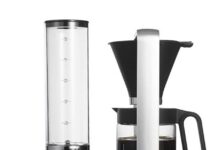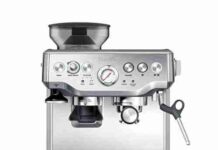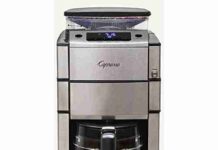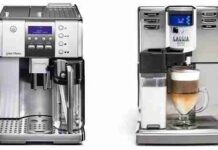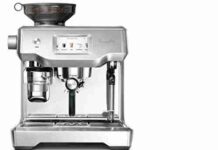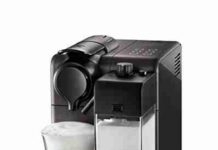Have you ever wondered the distinction between an espresso machine and a coffee maker?
This article will shed light on the differences between these two popular appliances. Whether you’re a coffee connoisseur or just starting your journey into the world of brewing, understanding the variations in functionality and methods will help you make a well-informed choice.
So, let’s embark on a delightful exploration of the divergent worlds of espresso machines and coffee makers.
Design
Espresso Machine:
Espresso machines are typically designed with a sleek and sophisticated look, often resembling a professional coffee shop appliance. Their design emphasizes functionality, precision, and the ability to produce high-quality espresso. Many espresso machines feature stainless steel components, large water tanks, and integrated milk frothers. They are often more complex regarding their inner workings, with multiple boilers or heating elements to ensure optimal temperature control.
Coffee Maker:
On the other hand, coffee makers are designed with simplicity and convenience. They come in various styles, from primary drip coffee makers to single-serve machines. Coffee makers are generally more compact and lightweight compared to espresso machines.
They are created to be user-friendly, with straightforward controls and easy-to-read water reservoirs. The design of coffee makers often focuses on delivering a quick and hassle-free brewing experience.
Operation
Espresso Machine:
Operating an espresso machine requires more skill and precision than a coffee maker. To make espresso, the user typically needs to grind the coffee beans to a fine consistency, measure the appropriate amount of coffee, distribute it evenly in the portafilter, and tamp it down with just the right amount of pressure.
The machine then forces hot water through the tightly packed coffee, resulting in a concentrated shot of espresso.
Coffee Maker:
Using a coffee maker is much simpler in comparison. The user usually only needs to measure the desired amount of coffee and water, load the coffee grounds into a filter, and start the brewing process.
Some coffee makers also offer additional features, like time programming and the ability to select the strength of the brew. The overall operation of a coffee maker is designed to be effortless and suitable for individuals who prefer a no-fuss brewing experience.
Brewing Process
Espresso Machine:
The brewing process in an espresso machine involves extracting the flavor from finely ground coffee by forcing hot water through the grounds under high pressure. This pressure allows for the extraction of more oils, solids, and aromatic compounds from the coffee beans, resulting in a concentrated and flavorful shot of espresso. The brewing time for an espresso shot is relatively short, usually around 25-30 seconds.
Coffee Maker:
Coffee makers, on the other hand, employ a drip brewing process. Hot water drips onto the coffee grounds in a filter, slowly passing through the grounds and extracting the flavor as it flows into the pot below. This brewing method is gentler and more prolonged than an espresso machine, resulting in a more subtle flavor profile. The brewing time for a whole pot of coffee can vary, but it is generally longer than the brewing time of an espresso shot.
Pressure
Espresso Machine:
One of the critical differences between espresso machines and coffee makers lies in the pressure used during the brewing process. Espresso machines generate significantly higher pressure, usually 9 to 15 bars, to force water through the coffee grounds. This high pressure is crucial for extracting the flavors and oils from the coffee quickly, producing a rich and concentrated shot of espresso.
Coffee Maker:
On the other hand, coffee makers do not rely on high pressure to extract the flavor from the coffee beans. They generally operate at atmospheric pressure, which is around 1 bar. A coffee maker’s slower drip brewing process relies more on gravity to move the water through the grounds, resulting in a less intense and milder cup of coffee.
Grind Size
Espresso Machine:
Espresso machines require a specific grind size to achieve optimal extraction. The coffee grounds must be finely ground, resembling fine sand or powder. This fineness allows the water to pass through the tightly packed grounds efficiently while still allowing for enough resistance to create the desired pressure during extraction. Using the wrong grind size can result in over-extracted or under-extracted espresso, affecting the taste and quality of the final product.
Coffee Maker:
Coffee makers are more forgiving when it comes to grind size. They typically require coarser grounds compared to espresso machines. Coarser grounds allow for a more prolonged extraction process, as the water flows through the coffee slower. While the specific grind size may vary based on the type of coffee maker used a medium-coarse grind is usually recommended for a balanced and flavorful cup of coffee.
Beverage Types
Espresso Machine:
Espresso machines are known for their versatility in producing a wide range of coffee-based beverages. In addition to espresso shots, they can create popular favorites such as cappuccinos, lattes, and mochas. This is made possible due to their ability to steam and froth milk, allowing the user to control the texture and consistency of the milk-based drinks. With an espresso machine, the possibilities for creating personalized coffee creations are endless.
Coffee Maker:
On the other hand, coffee makers are primarily designed for brewing regular coffee. They excel at producing a large volume of coffee quickly and efficiently, making them suitable for households or offices requiring multiple cups of coffee. While some coffee makers may come with a milk frothing feature, they are generally not equipped to create the same range of specialty beverages as an espresso machine.
Time
Espresso Machine:
Espresso machines are designed for speed and efficiency, capable of producing an espresso shot in seconds. The entire process can be completed in less than a minute, from grinding the coffee beans to pulling the shot. This makes espresso machines ideal for individuals seeking a quick caffeine fix or busy coffee shops where speed is of the essence.
Coffee Maker:
On the other hand, coffee makers take longer to brew a pot of coffee due to their drip brewing process. The brewing time can vary depending on the size of the pot and the desired strength of the coffee. On average, a whole pot of coffee takes about 5 to 10 minutes to be ready. While coffee makers may not be as fast as espresso machines, they make up for it by producing more coffee in one go.
Price Range
Espresso Machine:
Espresso machines tend to be more expensive compared to coffee makers. The price range for espresso machines can vary greatly, depending on factors such as build quality, brand reputation, features, and overall functionality. Entry-level espresso machines can start around $100 and can go up to several thousand dollars for high-performance commercial-grade models.
Coffee Maker:
On the other hand, coffee makers are generally more affordable and budget-friendly. They are available in a wide range of prices, from basic models priced under $50 to more advanced and feature-rich coffee makers costing a few hundred dollars. The price of a coffee maker often depends on factors such as the brewing capacity, brand, design, and additional features.
Strength of Coffee
Espresso Machine:
One of the defining characteristics of espresso is its intense and concentrated flavor. Espresso machines excel at producing a noticeably robust cup of coffee due to the high-pressure extraction process. The pressure forces water through the coffee grounds, resulting in a brew with a rich, full-bodied taste. The flavor profile of espresso is often described as intense, bold, and slightly bitter.
Coffee Maker:
On the other hand, coffee makers deliver a milder and less concentrated brew than espresso machines. As the water drips through the coffee grounds, it has more time to extract flavors gradually, resulting in a smoother and less intense cup of coffee. The taste profile of coffee made with a coffee maker is typically described as lighter, less acidic, and more suitable for those who prefer a less pronounced coffee flavor.
Maintenance
Espresso Machine:
Espresso machines require regular maintenance to ensure optimal performance and longevity. This includes tasks such as regular cleaning and descaling to remove mineral deposits that can affect the coffee’s taste and the machine’s efficiency. Many espresso machines also feature removable parts, such as the portafilter, steam wand, and drip tray, which must be cleaned separately. It is essential to follow the manufacturer’s instructions and guidelines for maintenance to keep the machine in a pristine condition.
Coffee Maker:
Coffee makers, while generally lower maintenance than espresso machines, still require routine cleaning and occasional descaling.
Cleaning the carafe, filter basket, and water reservoir after each use helps to remove any coffee residue and ensure the next brew is fresh and uncontaminated. Some coffee makers have a self-cleaning feature or dishwasher-safe parts, making the cleaning process even more convenient.
In conclusion, the difference between an espresso machine and a coffee maker lies in their design, operation, brewing process, pressure, grind size, beverage types, time, price range, strength of coffee, and maintenance requirements. Espresso machines are more complex and versatile, focusing on producing concentrated espresso shots and a variety of specialty beverages.
They require finer grind sizes and higher pressure and offer more customization options. On the other hand, coffee makers are more straightforward and more geared towards brewing regular coffee quickly and conveniently.
They operate at atmospheric pressure, have a broader grind size range, and produce milder, larger quantities of coffee. Understanding these distinctions can help coffee enthusiasts choose the right brewing appliance tailored to their preferences and needs.



